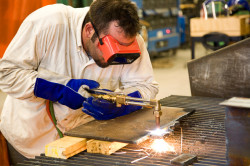 Metalworking fluids (MWFs) are designed to remove debris away from cutting and grinding machinery. This improves the lifespan of equipment by reducing friction and heat, which in turn reduces wear and tear on machinery. However, metalworking fluid may have negative effects on metal workers.
Metalworking fluids (MWFs) are designed to remove debris away from cutting and grinding machinery. This improves the lifespan of equipment by reducing friction and heat, which in turn reduces wear and tear on machinery. However, metalworking fluid may have negative effects on metal workers.
Metal workers may be exposed to metalworking fluid in a number of ways. First, they may get metalworking fluids on their skin from handling tools or metal coating in the fluids. Additionally, the action of machines may throw up fine sprays of droplets (called aerosols), which are easily inhaled.
According to the National Institute for Occupational Safety and Health (NIOSH), metalworking fluids like cutting fluid and cutting oil can cause a wide variety of health problems, depending on the exact metalworking fluid, the length and concentration of the exposure, and the route of exposure. The fluids themselves may be dangerous, or the flakes of metal or other substances they pick up may make them hazardous. Under some circumstances, dangerous microorganisms, like bacteria or mold, may colonize metalworking fluid.
Many of the diseases associated with metalworking fluids are skin diseases. They can cause several types of dermatitis (skin inflammation), as well as oil acne. Additionally, they can promote folliculitis, an inflammation of hair follicles in the skin, which shows up as tiny bumps on the skin. These reactions and infections can cause everything from minor discomfort to itching, burning skin lesions. Some of these ailments can have disabling complications.
>>Metalworking Exposure Lawsuits
NIOSH also links several lung disease to metalworking fluids. This includes MWF-induced asthma. In this reaction, aerosols (or less often, other types of exposure to metalworking fluids), sensitizes the lungs of patients to various types of asthma. Once someone is sensitized to asthma, regular allergic reactions can cause a dangerous restricting of that person’s airways. Asthma can be fatal. In addition to asthma, NIOSH states that metalworking fluid can cause an inflammation of the lungs called hypersensitivity pneumonitis or HP. This is very similar to asthma, but the inflammation is caused by the metalworking fluids directly, rather than later allergens in a patient sensitized.
Lastly, among the diseases linked by NIOSH to metalworking fluids, cancer is probably the most serious. According to NIOSH, there is “substantial evidence” linking metalworking fluid to cancers. This includes not only cancers of the skin and lungs, but also cancers of the bladder, pancreas, and scrotum. However, many of these cancers may take as long as 20 years to manifest, potentially obscuring their link with metalworking fluid in the minds of the victims. According to NIOSH, due to changes in the composition of metalworking fluids, it is very difficult to determine the cancer risk associated with metalworking fluids used after the mid-1970s. The link is more strongly established for these earlier formulations of metalworking fluids.
Get a Free Metalworking Fluid Injury Claim Review
Lawsuits have been filed by metal workers who went on to develop various diseases after using metalworking fluids. These lawsuits allege that the manufacturers of metalworking fluids were aware of the risks associated with this liquid, but continued to market them. These metal workers seek to recoup the cost of medical care associated with metalworking fluid.
If you or a loved one fell ill with a disease associated with metalworking fluid, you may be entitled to compensation. To explore your options, you can visit Metal Working, Cutting Fluid Exposure Class Action Lawsuit Investigation. Here, you can enter information about your situation for a legal review by a trained expert with a background in this type of litigation. The initial consultation is completely free of charge, and from it, you can receive additional guidance on the best steps take in your exact situation.
ATTORNEY ADVERTISING
Top Class Actions is a Proud Member of the American Bar Association
LEGAL INFORMATION IS NOT LEGAL ADVICE
Top Class Actions Legal Statement
©2008 – 2025 Top Class Actions® LLC
Various Trademarks held by their respective owners
This website is not intended for viewing or usage by European Union citizens.














